The Apple iPad 2 Review
by Brian Klug, Anand Lal Shimpi & Vivek Gowri on March 19, 2011 8:01 PM ESTThe UI & Honeycomb Comparison
The iOS UI hasn't changed much at all since the iPad launched last year. Apple eventually added folders and multitasking but this is still the same basic iOS we were introduced to with the iPhone 2G. On the plus side it keeps things simple. If you're an iOS user you're likely to feel right at home on an iPad. You can then pick up an iPhone or iPod Touch and get the same experience and even run many if not all of the same apps. Apple has always done a good job of taking care of its users that don't stray from the ecosystem and the iOS universe is no different.
There are still elements of iOS that I believe are unmatched in the industry. Apple does a great job focusing on how something should work and doing its best to implement that. To date I enjoy setting alarms/reminders more on iOS than any other mobile OS I've used.
Unfortunately, the iOS UI remaining relatively constant isn't always good. The multitasking UI is still not what I'd consider ideal. Switching between apps still requires a double tap of the home button, scrolling through a horizontal list of icons and tapping again once you found what you wanted. It's basically a less convenient alt-tab.
Notifications are also horribly obnoxious. When there was no support for 3rd party notifications in iOS it didn't really matter and the simplicity of the notification system was actually a benefit. However now all apps have the ability to send you notifications and many of them will actually attempt to do so. This results in an experience-breaking barrage of popups front and center on the iPad. While multitasking allows you to switch between an IM app, your email and a web browser, if you're casually talking to someone over IM you'll find yourself interrupted by popups as you try to simultaneously read email or browse the web.
The multitasking and notification limitations in iOS are actually two significant barriers that prevent the tablet experience from actually evolving.
In contrast we have the Motorola Xoom running Honeycomb. You can argue that the Honeycomb UI isn't nearly as smooth or consistent as iOS 4.3, however Google is experimenting with more productivity oriented UIs. Notifications in Honeycomb pop up in the lower right hand corner in a manner similar to what you'd expect from a desktop OS. Multitasking isn't perfect under Honeycomb either but you have an easily accessible list of the five most recently used applications that you can get to via a single tap. Google also took a very desktop-OS-like approach to navigation in Honeycomb - the nav/notification bar at the bottom always occupies screen real estate. It may fade out when you're in certain apps (e.g. watching a movie) but otherwise it's a permanent fixture. While not quite as invasive as the menu bar in OS X or the taskbar in Windows, the Honeycomb nav/notification bar is of the same family.
While Apple has definitely stepped up its ergonomics and performance with the iPad 2, the UI remains dated. I must point out that today, two years after the introduction of webOS, Apple still has yet to offer a multitasking experience that's anywhere close to what Palm did with significantly less resources. I'm not sure if this is a pride thing or a fundamental difference of opinion. If Apple keeps up its release schedule maybe we'll be surprised this summer with iOS 5.


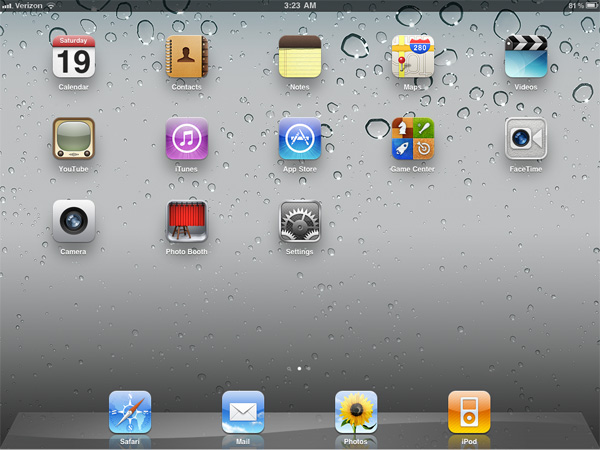
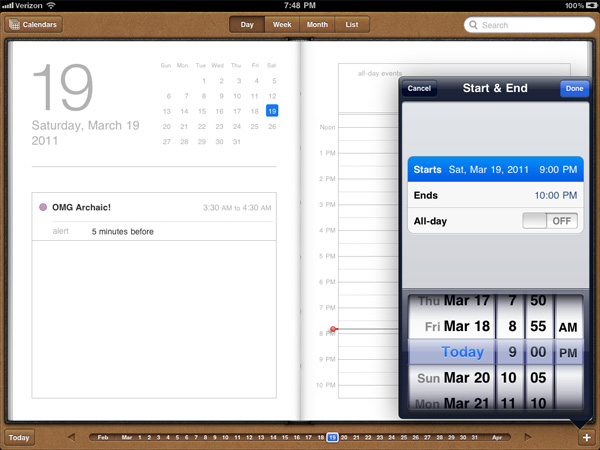
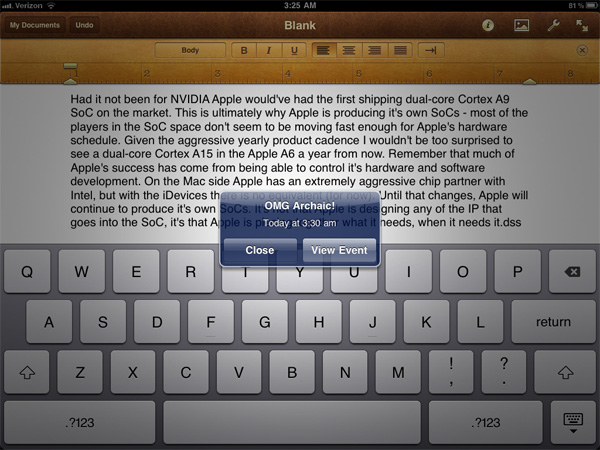
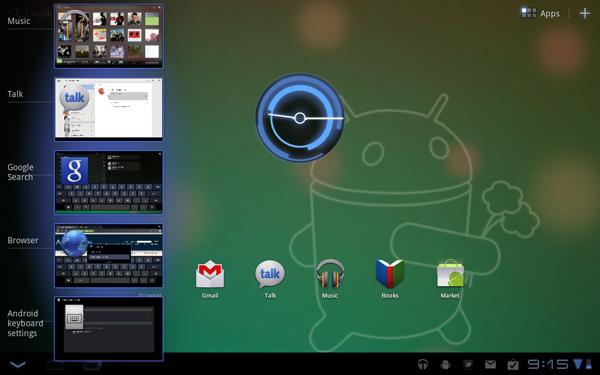
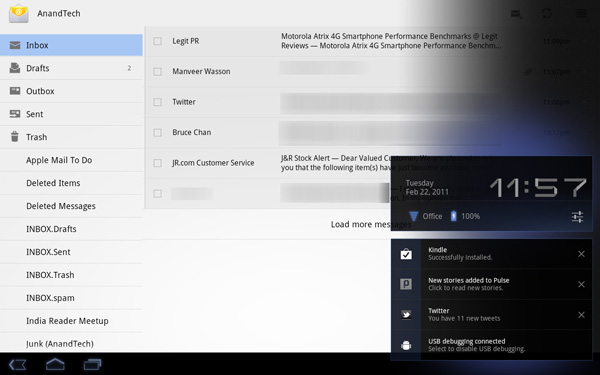








189 Comments
View All Comments
VivekGowri - Saturday, March 19, 2011 - link
I think it's $799, but I agree, it's too high. The equivalent iPad, at $729, is also way up there - really the only iPad that makes much sense as far as value goes is the base 16GB WiFi. I think the Xoom is probably going to have it's price cut by at least $100, if not $200, before it actually gets anywhere - ASUS took the right tack by putting it's lowest end Honeycomb tablet at $399.KoolAidMan1 - Saturday, March 19, 2011 - link
Where the iPad really works for me is as a travel device and in the living room. The iPad is just much nicer to use with in-flight wifi. Small, no cable management, and the battery will outlast a LAX-JFK roundtrip. My laptop lives in the overhead storage bin.You mentioned that the iPad has replaced the ThinkPad in airports, and I think that is spot-on. It is just so much more convenient and manageable to use compared to a laptop. I've left the laptop at home twice and I didn't miss it much, aside from not being able to play Starcraft 2 when I'm on the road. :)
The "sharing" aspect of the device has great advantages in a work environment, especially when you want to go over PDFs with a group of people. No need to crowd around or turn a laptop, just pass around the iPad.
As for the living room and bedroom, self explanatory. Not being tethered to the home office in order to fire off email is nice. Ditto using it as a universal remote in the living room.
It is a luxury device and a supplement, absolutely, but a damn good one.
nickdoc - Sunday, March 20, 2011 - link
Finally a sensible person. We are definitely on the same page.kevith - Sunday, March 20, 2011 - link
"You're absolutely right" almost always really means: "I totally agree..." :-)relentlessfocus - Saturday, March 19, 2011 - link
As always a real insight into the hardware. I'd like to make an observation about generalising from your own inability to find something that tablets add to your PC./smartphone mix to the larger sphere of buyers. Indeed most are not crazy and overly rich.My friends have a 2 year old child. I have no doubt that eventually she'll be reacting with laptops and desktops but my oh my how much my friends talk about the 3 of them with the iPad. Not an Anandtech thing... fine. A real life use. I think so.
Jake Humphrys is the lead for BBC's Formula 1 coverage here in the UK. While talking live in the pits with his co-commentators he now holds an iPad cupped in his hand that he gracefully reads from and then puts to his side as he gets live update info from his directors as the show is broadcast. OK, its not an Anandtech thing but its a real life use for a tablet that you wouldn't do with a netbook or notebook.
It's being used by coaching staff in sports and by doctors making their rounds in hospitals. It's used by major corporations for field workers running in house bespoke apps for catalogues and inventory and real time pricing etc. It's used by estate agents in the field with their clients and its used in trendy clothing shops like All Saints to display the entire store catalog for customers to browse. I could without a doubt put together 100 real life uses that "did figure out a use for it" distinctive from what you might do with a netbook or laptop or even desktop.
Your reviews set the gold standard in so many ways but in this one way its a shame you brought such a limited perspective to the usefulness of touch tablets in the world at large. I understand that people who do certain kinds of work really do find that a touch tablet device may not be useful, indeed you may not own a pickup truck or headphone amplifier. But the slant of your article and some of the comments above implies a great generality than I think can be justified.
Anand Lal Shimpi - Saturday, March 19, 2011 - link
First of all, thank you for your kind words - I really do appreciate them.I don't doubt that there are specific uses for a tablet that a notebook cannot do as well. I mentioned one of these in the review - simply passing around the iPad for others to look at, information sharing, it's a lot easier to do this than with a clunky notebook.
My point about the usefulness is that it's currently not powerful enough, flexible enough and ergonomic enough to completely replace a notebook. I'm not saying it won't get there, but I don't believe it's there today. The iPad 2 is a great device, but it's an augment to existing computing devices - and for some users that's tough to integrate into their existing workflow.
If you can find a fit that makes sense however, it's a great device.
Take care,
Anand
Azethoth - Sunday, March 20, 2011 - link
Good article. However I do not think the point of tablets and smartphones are to replace netbooks. I think their point is to compete on apps. If they can do something critical to someone better than another form factor then they win a sale. I think it will turn out there are more apps that are tablet appropriate than netbook appropriate.Unless there are more interface revolutions I just do not think there can be a 100% intersection between netbook and tablet utility. So while netbooks will remain better at the things a lot of people complain about not being able to do on a tablet, tablets will eat their lunch market share wise because of the many more things they do good enough or perfectly.
Fontanka - Sunday, March 20, 2011 - link
"Workflow ", "Use", "Users","Usefulness".........That's not what most of the 15 million purchasers (and counting) are thinking about....they want to communicate, be entertained and diverted when NOT WORKING. The iPad delivers.
Fontanka
WaltFrench - Sunday, March 20, 2011 - link
@Anand, let me second the kind words of @relentlessfocus.And also his point: a tablet and a notebook are largely incommensurable.
Lightweight, sub $1000 notebooks with 11-hour battery life, compressed learning times and near-instant app startup don't exist.
Likewise, notebooks don't have anywhere near the touchscreen's I/O capabilities, which you call out as great in iMovie and GarageBand. (I'd add the iOS app I use for writing Chinese as part of my studies, and the painting app used by high profile artists to create New Yorker covers.) Then, there's a new mix of software appropriate to mobile life, including the many “specialized” apps @relentlessfocus offered.
I get that, by definition, our current workflows can't be optimized on a tablet. (Mine, with multiple screens on the desktop, and a bigscreen laptop, would be horrible. Why would I even think to try?) These things are "technical disruptors," "creative destructors," "inventor's dilemmas," however you want to characterize them. They enable new usage modes at the same time that they're not as good, or downright awful, for the old ones. They serve new customers better than the old; this is all old hat ever since Shiva got incorporated into the pantheon.
But thanks for such a complete review, for those of us who happen to be dabbling in devices that enable new functions, new activities.
Anand Lal Shimpi - Sunday, March 20, 2011 - link
I believe we're actually in agreement here. The tablet is a disruptive form factor and a disruptive device. In the article I state that I believe there's a glorious future for tablets, however I believe we're still at an early point in the evolution. Since we're operating on a faster-than-moore'slaw-curve here, you're looking at a 12 month product cycle with these things. As such I believe a cautious approach to investment is better, especially given the price points we're talking about.By all means, if you have the money to spend and have a genuine use for it - the iPad 2 is a great device. I'm genuinely giving the iPad 2 another chance, I really wanted to use the iPad 1 I just found myself carrying it and a notebook wherever I went.
For example, I'm traveling now for CTIA but I brought the MacBook Air. I'd much prefer reading comments on the iPad 2, but I like responding to them on the Air. I don't really know what the right solution is to that problem. It can't be to have one device for reading web pages and another device for contributing to web sites? I believe there's still a lot of work to be done here, that's all I'm saying - not that the iPad or the tablet are doomed.
Take care,
Anand